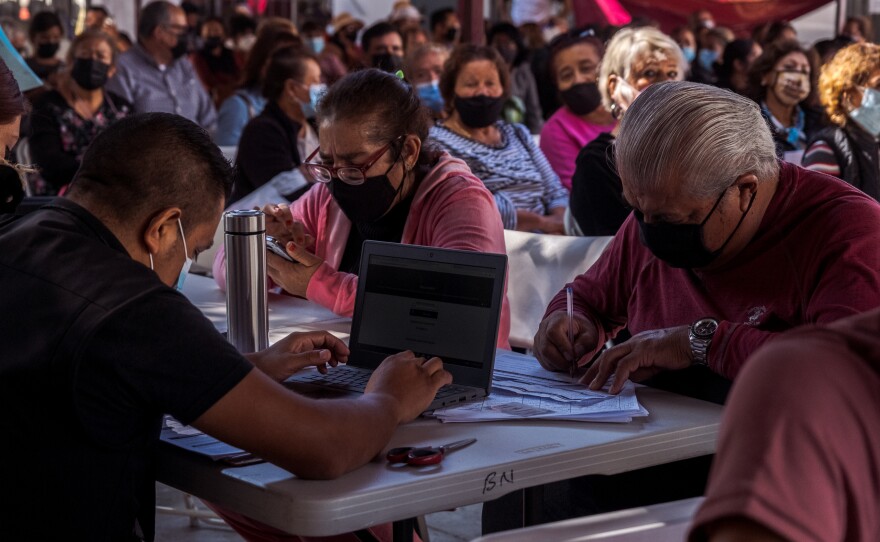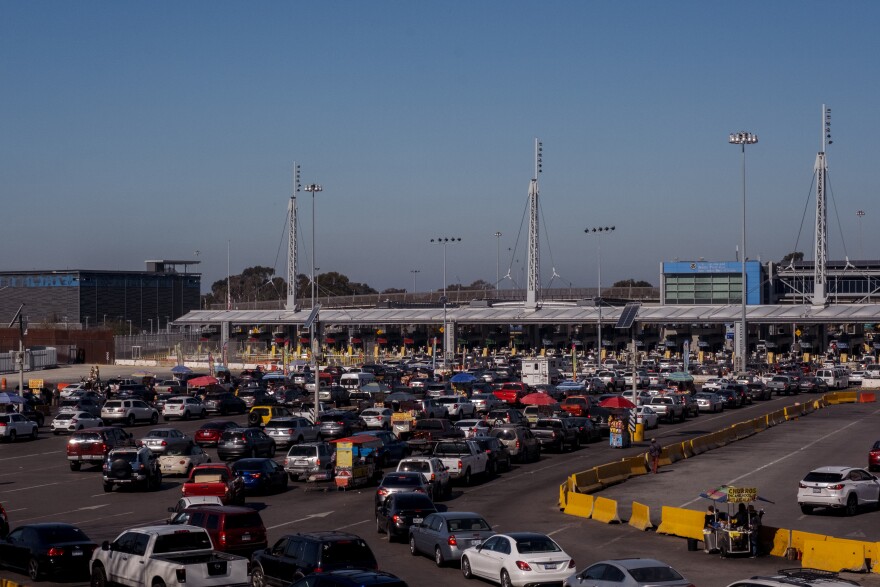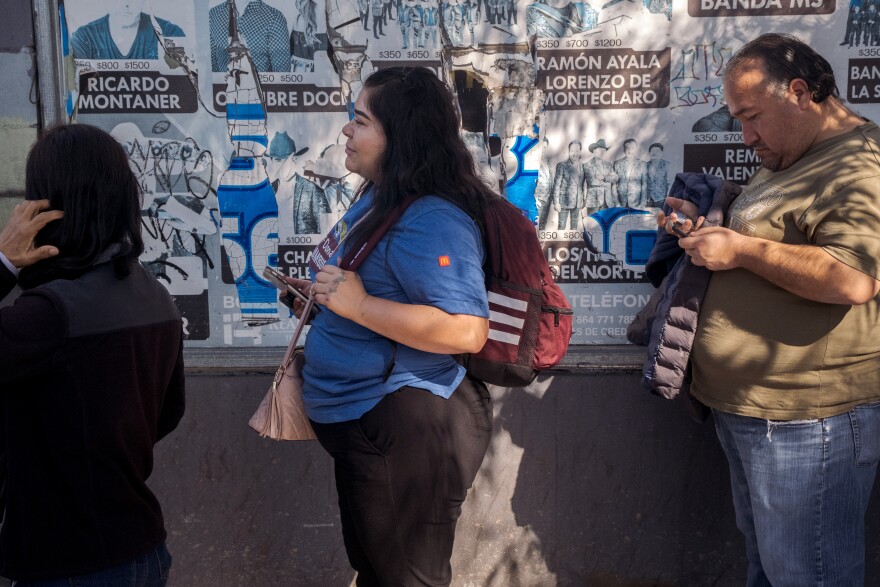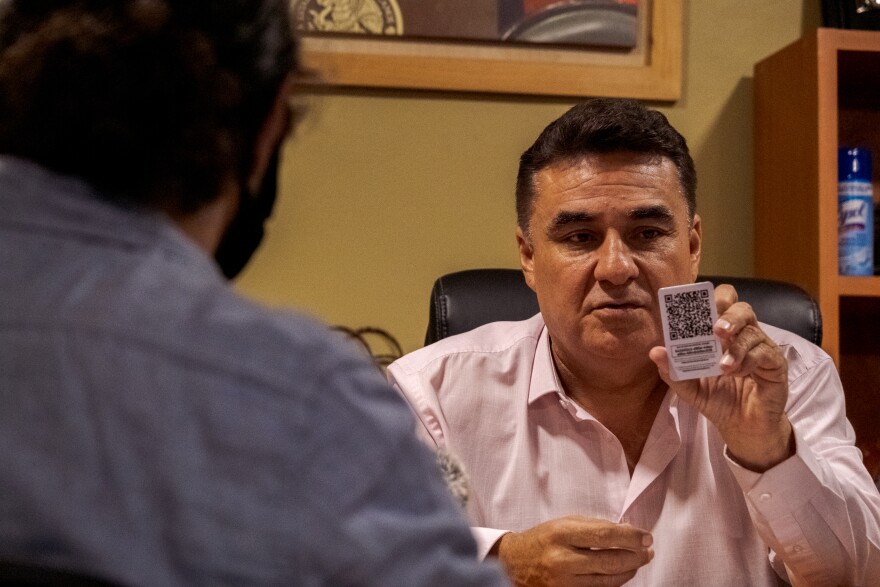Tens of thousands of Tijuana residents are scrambling to get proof of vaccination as the U.S. finally lifts a COVID-19-era restriction on non-essential border crossings Monday.
While people on both sides of the border initially cheered the long-waited lifting of the travel ban, problems with Mexico’s vaccine certification documents and news of longer border wait times have become a significant concern.
RELATED: San Ysidro Port of Entry prepares for Nov. 8 reopening for non-essential travel
“I have relatives on the other side who I haven’t seen in 19 months,” said Luis Angel Reyes.
Reyes spent Wednesday morning in line with 1,200 other Tijuana residents outside of the Secretaria del Bienestar in Zona Rio. That’s the building where people who have problems with their vaccination certificates go to request corrections.
To get the official vaccine certificate in Mexico, people need to transfer data from their original vaccination receipt into a government system. That system verifies the data and gives each person a certification with a QR code that officials can use to verify someone’s identity.
“They say it takes three months for them to issue a correction. We’ve been waiting 19 months. Black Friday is almost here and we won’t be able to go until next year.”Sonia Hernandez, waiting for vaccine certification
The most common error is that the information in the original receipt doesn’t match the information in the official certification. If someone gave the wrong address, for example, the federal government will not issue an official certification.
That is the case with Sonia Hernandez, who said she cannot receive the official certification because of a problem with her address. That error will take 90 days to correct.
“They say it takes three months for them to issue a correction,” said Hernandez. “We’ve been waiting 19 months. Black Friday is almost here and we won’t be able to go until next year.”
Blame game
Who is at fault depends on who you ask. Government officials say people lied on their paperwork because they distrust the government.
“A lot of people wrote false information,” said Jesus Alejandro Ruiz Uribe, Baja California’s Federal Delegate, who oversees social programs in the state. “They didn’t want the government to know their phone number, or ID, or email addresses. It’s their fault. It’s not the government’s fault. But we are here to solve it.”
Ruiz Uribe said this is happening all over Mexico, which is why it takes 90 days to issue corrections.
Tijuana residents waiting in line to get corrections disagreed with Ruiz Uribe’s assertion that the fault lies on them.
Hernandez said she didn’t write down the wrong address. She blames government employees for the blunder that may keep her from crossing the border.
Reyes, the man who hasn’t seen relatives in 19 months, said the government website used to get the certification keeps crashing on him. He faults Mexico for creating a complicated system.
“On the other side the people get vaccinated and get their certificate right away,” he said. “If this is something global why don’t all countries do this the same way?”
As the reopening approaches, some Tijuana residents are growing frustrated by the fact that American tourists don’t have the same vaccination requirements.
RELATED: The U.S. has new COVID vaccine rules for international travelers. Here's what to know
“There are a lot of Americans who don’t want the vaccine,” said Carmen Hernandez. “They can come here but we can’t go there. It’s discrimination.”
There is also a lack of clarity on what documents U.S. Customs and Border Patrol (CBP) agents will accept. Ruiz Uribe said only the official certification will be accepted at the border. The original document is just a piece of paper that can be easily forged, he said.
CBP officials confirmed that agents at the border will accept Mexico’s official certificate as proof of vaccination. However, they did not rule out accepting the original vaccination receipt.
KPBS sent CBP officials a photo of the original receipt and asked if it would be accepted. They have not responded.

Long waits
On Wednesday, Moises Castillo, head of the San Ysidro Port of Entry, held a press conference detailing new border crossing protocols that will take effect Monday morning.
Castillo said every non-essential traveler will be required to have proof of vaccination. But not everyone will be required to show it.
Instead, Border Patrol Officers at pedestrian and vehicle booths will simply ask for verbal confirmation. They will only ask to see the proof of vaccination on a case-by-case basis, an approach similar to how they inspect vehicles.
Castillo also said to expect longer border wait times.
“As we lift restrictions, we are expecting an increase in travelers and we are also expecting an increase in wait times,” he said.
Border wait times at the San Ysidro Port of Entry were already notoriously long and have had a negative impact on San Diego’s economy, said Kenia Zamarripa of the San Diego Chamber of Commerce.
“They result in work delays or lost jobs,” she said.
Throughout the pandemic, businesses have complained to Zamarripa about what she describes as a snowball effect of longer border wait times.
“They tell us their workers are stuck at the border so long that they turn around and leave,” she said. “So, what happens is we have businesses in Otay Mesa that are short staffed. When we talk about this going on for 18 months, the businesses lose their credibility and some of their clients go to competitors outside of San Diego. Or some companies hold off on previous plans to expand in San Diego.”
Still, Zamarripa said news of the reopening is a net positive. Even with the possibility of longer wait times.
“This is great news, especially for South County,” she said. “Even with the border wait times, this is a new opportunity to reconnect with their consumer base, to reconnect with cross-border workers and at least keep that flow of tourism injected into the San Diego economy.”
Castillo said CBP officers are being reassigned in border booths from other roles in anticipation of increased traffic. However, he said there are no plans to reopen the PedWest pedestrian crossing. CBP will also keep one officer instead of two per booth in the vehicle lanes.
When KPBS visited the Mexican side of the border Wednesday, 10 of the port’s 34 vehicle lanes were closed.
Evagelina Sanchez has already waited 19 months to cross into the U.S. She doesn’t mind waiting another few hours, she said.
“I’ll bring a tent to sleep on the line,” she joked.
This story was produced with support from the Economic Hardship Reporting Project.












